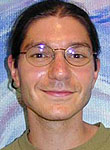Black holes won't suck us in, can be source of brightest lights, says expert
By Vivek Venkataraman

Black holes are real, come in a range of sizes and can actually be seen, said this year's Salpeter lecturer March 13.
Eliot Quataert, a professor of astronomy and physics at the University of California-Berkeley, began by explaining that "escape velocity" specifies how fast one needs to throw an object from the surface of a massive body (like a planet or star) for it to overcome gravity and escape into space. On Earth, it's about 11 kilometers per second; on the sun, it's 600 kilometers per second. The more mass a body packs into a smaller size, the higher its escape velocity.
In the late 1700s, scientists asked, "What if a star were so massive and so small that its escape velocity exceeds the speed of light (300,000 kilometers per second)?" They called this object a dark star, one that couldn't be seen because no light would come off it.
We now refer to this object as a black hole, Quataert said.
While Einstein's General Theory of Relativity was used to produce a mathematical description of black holes in 1916, the implications were not understood and accepted until the 1960s. In black holes, Quataert said, all matter and information remains trapped.
Quataert dispelled such popular myths as black holes being cosmic vacuum cleaners and the danger of us being suddenly sucked into one.
"If you are far away … a black hole is no different from any other massive object. If the sun were to be replaced by a black hole of equal mass, the earth wouldn't get sucked in and would happily go around in its orbit," Quataert explained.
Stars have a balance between the inward pull of gravity and the outward push of pressure from hot gases. "This happy balance exists because of nuclear fusion reactions in the center of the star that heat up the surrounding gases. These eventually run out," Quataert said.
Gravity then takes over, causing the star to collapse in on itself. Stars more than 30 times as massive as the sun collapse to a single point in space, forming a black hole. In addition to these relatively small black holes formed from stellar deaths, supermassive ones exist at the center of most galaxies.
Astronomers can detect black holes by observing the effects of their strong gravity on nearby objects, he said. Scientists have deduced, for example, that near the center of the Milky Way there is a black hole with a mass 4 million times that of the sun.
Counterintuitively, black holes can also be the brightest sources of light in the universe. Gas and dust just outside a black hole can spiral in toward the center, get extremely hot and release large amounts of radiation that is easily detected, Quataert said.
The Salpeter Lecture Series was established in 1998 to honor Edwin E. Salpeter, a professor of astronomy and physics at Cornell for more than 50 years until his death in 2008. Salpeter is considered one of the most important astrophysicists of the 20th century for elucidating how carbon is produced in stars and deriving the formation rates of stars of different masses, among numerous other influential works.
Graduate student Vivek Venkataraman is a writer intern for the Cornell Chronicle.
Media Contact
Get Cornell news delivered right to your inbox.
Subscribe